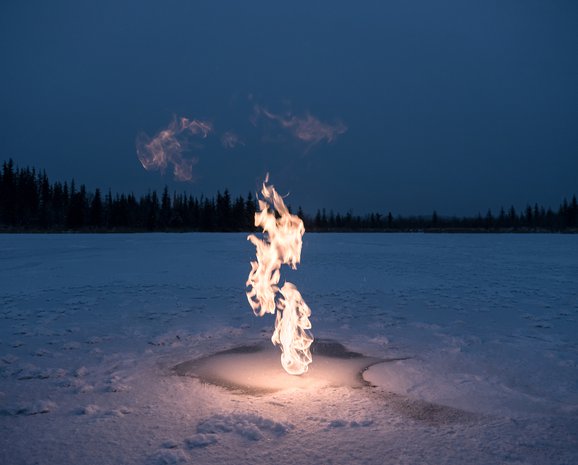Benedikt Partenheimer
Memories of the Future
For his series Memories of the Future (2017), Benedikt Partenheimer travelled to Alaska to study the impact of global warming on the permafrost through photography. The two photographs Methane Experiment show flames that the artist lit at a methane gas bubble that had formed beneath the ice of a frozen lake. The pictures reveal what cannot be seen with the naked eye, yet has such fatal consequences for the Earth’s climate: greenhouse gases escaping due to the thawing of the permafrost. If the permafrost continues to thaw at an accelerated pace due to climate change, these reservoirs will open up and release considerable quantities of carbon dioxide and methane, further exacerbating the global warming phenomenon. Permafrost is therefore a key tipping element in the Earth’s climate system. In his photographic series Drunken Trees, Partenheimer illustrates one such tipping event. Indeed, with the thawing soil rendered unstable, the trees gradually lose their footing, as it were, and subside. This process known as thermokarst has also caused damage to infrastructure and prompted the resettlement of entire villages. Partenheimer superimposes several image planes and incorporates graphic elements that elongate the tilt angle of the trees. His haunting photographs toy with our way of seeing things and highlight complex processes of transformation, in our ecosystem.
Benedikt Partenheimer, born 1977, lives in Berlin, Germany.
Melting Permafrost
Ever since the Last Glacial Period some 20,000 years ago, the northern hemisphere (Siberia, Canada, Alaska) has had an extensive area of permafrost, accounting for approx. 25 per cent of the land area. This means that, for thousands of years, the ground has been frozen all year round, sometimes to great depths, thawing only superficially in summer. In addition to the observable melting of the glaciers in Arctic and Alpine regions and the resulting rise in sea levels, climate change is also causing the permafrost to thaw. The soil in the affected regions becomes unstable, threatening the infrastructure that is built on top of it, i.e. railways, roads, buildings and power lines. Landslides, rock falls and mudslides are an increasingly frequent occurrence, along with the risk of major fires raging out of control. Micro-organisms then begin to break down the thawed organic material, creating large gas bubbles in the soil. Carbon dioxide, but also large quantities of methane – which itself has a huge impact on the climate – escape into the atmosphere, further accelerating climate change.
Sources
- Klimagefahr durch tauenden Permafrost? UBA-Hintergrundpapier, Umwelt Bundesamt, Desssau, August 2006.
- Permafrost taut durch Klimawandel: Wie wirkt sich das auf Ökosysteme der Arktis aus? Result in Brief, H2020, CORDIS – European Commission. [EU-Projekt: Permafrost thaw – decadal responses to climate change (PERMTHAW), Universität Göteborg.]
- Roland Knauer, Permafrost: Die Zeitbombe im hohen Norden, in: Spektrum.de, 05.09.2019.
Artist Statement
"I have photographed drunken trees, which are trees that have lost their ability to stand upright and which I think are a perfect symbol for a world that has lost its balance."
Benedikt Partenheimer, artist
Artist Edition
by Benedikt Partenheimer
Exclusively for the exhibition Nach uns die Sintflut a work by Benedikt Partenheimer is available as an artist's edition. Go the Onlineshop



